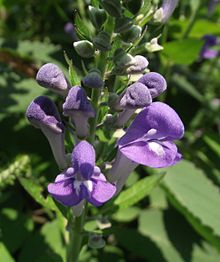Autumn skullcap
| Autumn skullcap | ||||||||||||
|---|---|---|---|---|---|---|---|---|---|---|---|---|

Autumn skullcap ( Scutellaria incana ) |
||||||||||||
| Systematics | ||||||||||||
|
||||||||||||
| Scientific name | ||||||||||||
| Scutellaria incana | ||||||||||||
| Blast |
The fall skullcap ( Scutellaria incana ) (English: Downy skullcap , hoary skullcap ) is a plant type from the genus of Scutellaria ( Scutellaria ) within the family of Labiatae (Lamiaceae). The deciduous perennial is native to dry forests and clearings in the north-central, east, and southeastern United States . It bears flowers in late summer and is common as a robust ornamental plant in gardens and parks .
description
The autumn skullcap is a deciduous shrub with upright, heavily branched, 60–120 cm high, more or less square stems. The above-ground parts of the plant are finely haired, but not glandular or sticky. The cross -opposite, simple and pointed to round-pointed leaves have short stems. They are usually egg-shaped to, more rarely, elongated or elliptical and notched to serrated on the leaf margin, up to 10 cm long and 4 cm wide, light green below and almost bald on top and finely hairy below. At the base they are pointed to clipped or slightly heart-shaped.
The stems end in many-flowered, racemose inflorescences with white-violet to -bläulichen, finely hairy outside, 1.5-2 cm long, scentless and shortly stalked, fivefold and hermaphrodite flowers with a double perianth . Each flower consists of a two-lipped and funnel-shaped corolla and a small, two-lipped, green and fine-haired, bell-shaped calyx. The smaller, two-lobed upper lip is narrow and hood-shaped, the larger, weakly three-part lower lip is wide and has a conspicuous white spot in the middle. There is a small elliptical bract at the base of each flower stalk . Flowering time is August to September. The Klaus fruit with / in the constant calyx with an appendage (spur, hump) disintegrates into two to four solitary partial fruits (Klaus).
ecology
The flowers are mainly pollinated by bumblebees . Other visitors include hover flies , dragonflies and small butterflies , which are less likely to cause cross- pollination . Some species of wasps can bite through the base of the flower and "steal" nectar. Insects that feed on the leaves of the autumn skullcap include various species of flea beetles and caterpillars of leaf miners and splayed butterflies .
Occurrence
The fall skullcap is common in the eastern part of the United States from New Jersey and New York to Illinois and Iowa , south to North Carolina , Alabama , Arkansas and Kansas . Natural habitats include mountain forests , rocky, thinly forested mountain slopes and river banks , mountain meadows , bushes and roadsides .
use
The autumn skullcap is suitable as a robust ornamental plant for sunny places and moderately dry soils on the edge of the wood . The plant is considered a valuable late bloomer with a long flowering time. It can be combined well with other North American wild perennials such as rudbeckia and sun bride. The ash-gray seed heads are also noteworthy. They look similar to small baseball caps . The plant prefers partial shade and loamy, moderately dry, well drained soils . But it also copes well in full sun, sandy soil, and wetter conditions. The autumn skullcap can withstand frost down to −29 ° C ( zone 5 ).
Systematics
The first publication of Scutellaria incana took place in 1807. Three varieties are available in the United States widely used:
- Scutellaria incana var. Australis (Epling) Collins ex ined. (Syn .: Scutellaria altamaha subsp. Australis Epling ): It occurs in the southeastern United States.
- Scutellaria incana blast. var. incana : It occurs in the north-central and eastern United States.
- Scutellaria incana var. Punctata (Chapm.) C. Mohr : It occurs from the southeastern United States to West Virginia .
literature
- Leo Jelitto, Wilhelm Schacht , Hans Simon: The outdoor ornamental perennials, manual and lexicon of garden perennials. Volume 2: I to Z , 5th, completely revised edition, Verlag Eugen Ulmer, Stuttgart (Hohenheim) 2002, ISBN 3-8001-3265-6 , p. 841.
Web links
- Scutellaria incana at Missouri Plants.
- Scutellaria incana at KEWScience.
- Autumn skullcap (Scutellaria incana) in the Encyclopedia of Life . Retrieved July 6, 2020.
- Scutellaria incana at Natural Resources Conservation Service, USDA.
- Downy Skullcap at Illinois Wildflowers.
Individual evidence
- ↑ a b c at Illinois Wildflowers.
- ↑ in Encyclopedia of Life.
- ^ A b Leo Jelitto, Wilhelm Schacht , Hans Simon: Die Freiland-Schmuckstauden, manual and lexicon of garden shrubs.
- ↑ Richard Hansen , Friedrich Stahl: The perennials and their areas of life. 6th edition. Verlag Eugen Ulmer, Stuttgart (Hohenheim) 2016, ISBN 978-3-8001-8385-2 , p. 328.
- ^ Piet Oudolf, Henk Gerritsen: Dream Plants for the Natural Garden. Frances Lincoln, London 2011, ISBN 978-0-7112-3462-8 , p. 51.
- ^ The Royal Horticultural Society: Perennials, The Great Encyclopedia. Dorling Kindersley Verlag, Munich 2015, ISBN 978-3-8310-2752-1 , p. 428.
- ↑ Curtii Sprengel Mantissa prima Florae Halensis, p. 44, 1807, online at biodiversitylibrary.org.
- ↑ Rafaël Govaerts (ed.): Scutellaria. In: World Checklist of Selected Plant Families (WCSP) - The Board of Trustees of the Royal Botanic Gardens, Kew .

